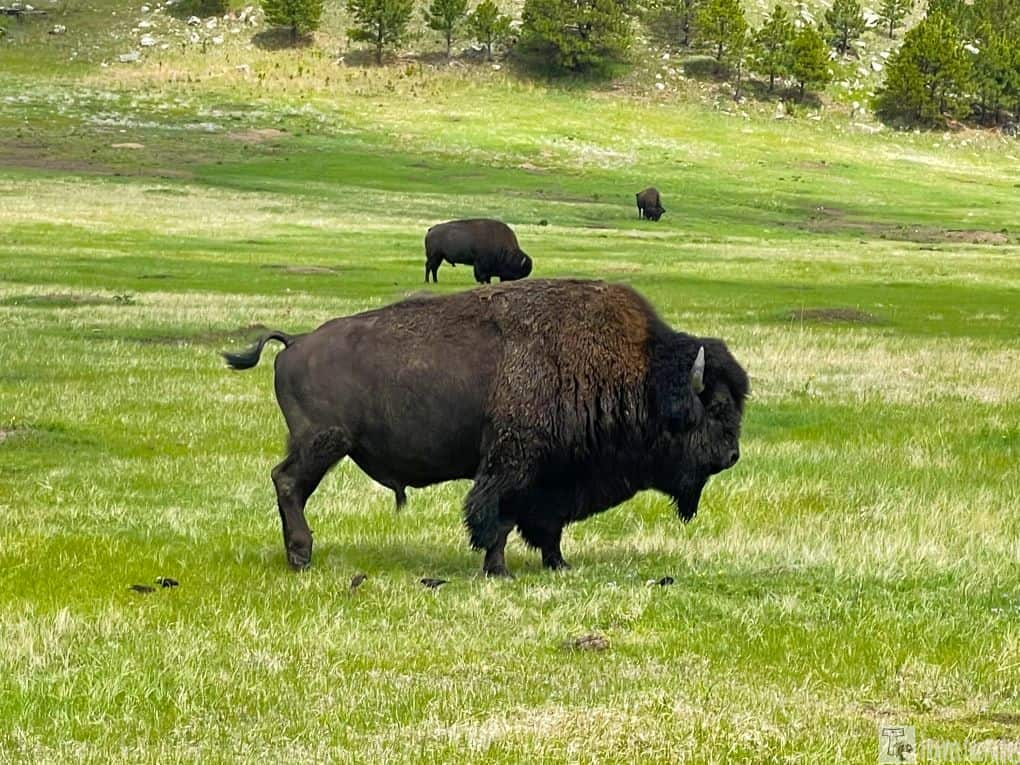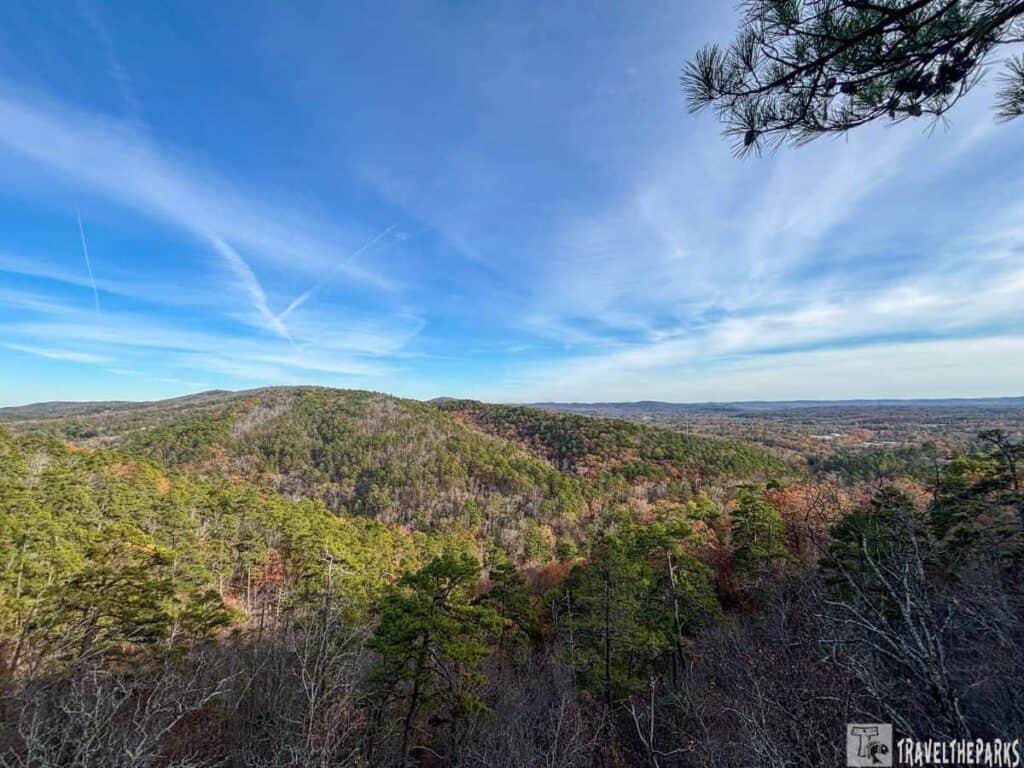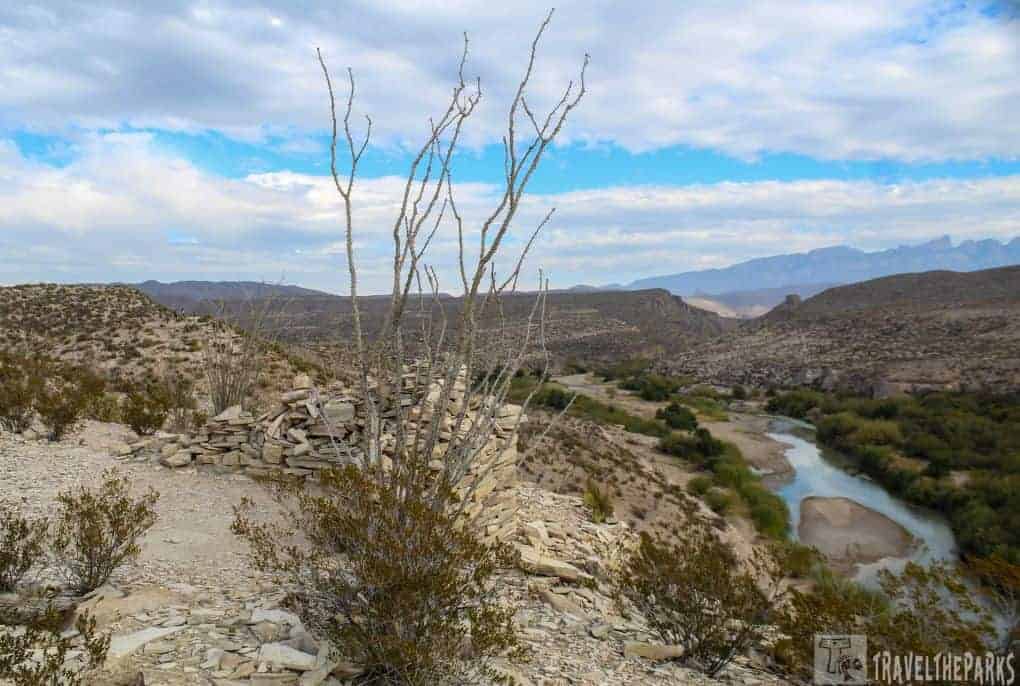As part of our Black Hills of South Dakota adventure, a day at Wind Cave National Park was an unanticipated surprise. Wind Cave is one of the most underrated national parks. The real hidden gem is the natural grass prairie above the ground, although there is something magical and otherworldly about being underground in a cave.
Wind Cave features the world’s 7th longest and complex cave system. Theodore Roosevelt established Wind Cave National Park in 1903. The park terrain covers 33,971 acres.

This post may contain affiliate links, meaning if you purchase something through one of these links, we may earn a small commission at no extra cost to you! Read the full disclosure policy here.

Table of Contents
How to Get to Wind Cave National Park
Wind Cave National Park is open all year, but is busiest in the summer months. There is no entrance fee for the park. The closest major airport is Rapid City Regional Airport. Approximately 1-hour drive from Rapid City, take SD-79 South 54-miles to US 18. Turn right onto Highway 385 North 10 miles into the park.
- From the Black hills, take U.S.16 south. Turn west onto U.S. 385 toward Hill City, SD. Continue on US 385 through Custer City, SD. It is 13-miles to the park. On your left, follow the signs for the visitor’s center.
- Turn left on US Hwy. 385 south to Hill City and continue south through Custer City. The park is about 20 miles south of Custer, SD off U.S. Hwy 385.
- From Hot Springs- Take US 385 10-miles north. Follow the park signs the 0.5 miles to the visitor center.
- Elk Mountain Campground is the only place to stay in the park. The campground is open year-round, however there are services limited services during the off season.

Historic Civilian Conservation Corps Architecture at Wind Cave National Park
In the 1930s, the Civilian Conservation Corps built many of the park buildings, which are historic landmarks. The elevator building dates to circa 1938, the Superintendent’s Cottage 1905, the Superintendent’s Residence 1934. They constructed the Visitor Center in 1934. All constructed using sandstone blocks taken from the nearby quarry. Today, many of these wood-framed buildings provide housing for employees, their historical characteristics intact are still visible.

Essential Info: What to Know Before Your Wind Cave Itinerary for a Day Visit
- Operating Hours: Park Grounds: Open 24 hours a day, year-roun. Visitor Center: Open daily from 8:00 AM to 4:30 PM, except on Thanksgiving, Christmas, and New Year’s Days.
- Entrance Fees: It’s FREE! Cave Tours Require Tickets: Reserve your cave tour in advance at recreation.gov—spots often sell out quickly, especially in summer. Arrive Early Morning tours fill up fast. Arrive early to check in, explore the visitor center, or hike nearby trails before your tour.
- Best Time to Visit: Late spring to early fall offers the best weather and full tour availability. Winter hours and tours are limited.
- Pet Policy: Pets must be leashed at all times (maximum length of six feet) and should not be left unattended. Leashed pets are welcome on the Elk Mountain and Prairie Vista Nature Trails, in the grassy areas around the Visitor Center, and within the boundaries of the Elk Mountain Campground. They are not permitted in the cave, public buildings, backcountry, or on most trails.
- Cell Service is Spotty: Download maps and confirmation emails in advance; don’t rely on GPS alone.
- Junior Ranger Program: Great for kids and families—pick up a booklet at the visitor center and earn a badge.
Start Your Day One Day Tour at the Visitor Center
All cave tours will begin at the Visitor’s center. In the summer months, the center is open 8:00 AM – 6:00 PM daily. It is open every day of the year except Thanksgiving, Christmas, and New Year’s Days.
The educational displays in the visitor’s center museum describe the geology of the cave and the flora and fauna that live in the park. Since you have to arrive for cave tours at least 30-minutes in advance, you can read through the displays before your tour begins. We arrived super early for our tour, having enough time to do the short Prairie Vista Trail. The trail starts outside the door’s bottom floor of the visitor center or the picnic area 0.15 miles north of the road.

Things to Do in a Day at Wind Cave National Park: Hike to the Natural Entrance
The trail is a 1.0 mile loop that passes through prairie grassland and the cave’s natural entrance. For many years, visitors could only enter the cave through the Natural Entrance. Wind Cave gets its name from barometric pressure at its entrance, which puts the wind into the cave. This movement of air creates wind, including wind at the cave entrance, as it moves from higher to lower pressure zones. An informational kiosk tells of the sacred importance of the site to the Lakota peoples.
A short side trail climbs a rise to the burial site for Alvin McDonald, one of the first explorers of the wind cave system. He mapped the first 7-8-miles of the cave using only a candle at the tender age of 18. Hard to imagine what that was like. Sadly, a marked plaque details how he succumbed to typhoid fever at 20, in 1893.

Wind Cave’s Sacred Origins and Early Discovery – A Must-See on Your One-Day Tour
Did you know Wind Cave is the site of the Lakota Emergence Story? Wind Cave is a sacred site, representing part of the Lakota creation narrative: Lakota Emergence Story. According to this story, Wind Cave is a passageway through which a portal leads to the Spirit World, which is where the first humans lived, waiting for the earth to be ready. The Lakota have a spiritual connection to the cave. Lakota people refer to Wind Cave as Maka Oniye, which literally means “breathing earth.”

Cave Tour Tickets & Information
You must go on a ranger-guided tour in order to see Wind Cave. Online reservations are available for Wind Cave Tours. On www.recreation.gov, search for Wind Cave Tours to book tours up to 120 days in advance. A three-day blackout period applies to reservations. Please visit the park website for additional information.
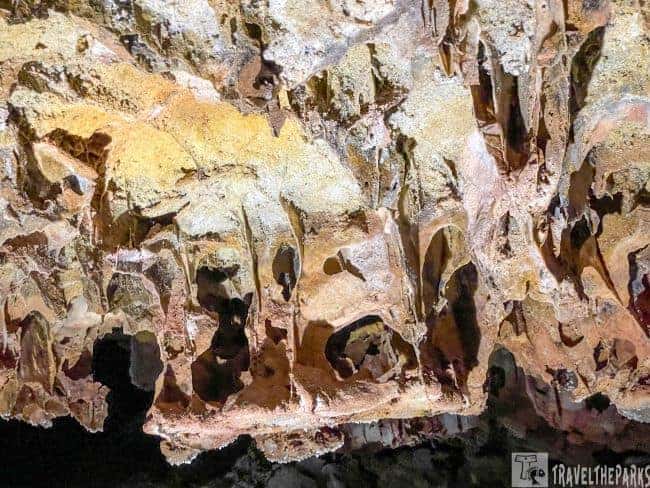
Rules for Entering the Cave
- Backpacks, bags, & purses, water bottle, food stuffs and selfie sticks are NOT allowed inside the cave, including baby backpack carriers (front carriers allowed).
- Bring a jacket or sweater. It’s 53 degrees inside the cave.
- Wear closed-toe shoes or hiking boots–NO flip-flops or sandals.
- Cameras and flash photography are allowed.
- Please do not touch cave formations; the oil from your hands can damage them permanently.
- Watch your head, low hanging ceiling.
- White-nose syndrome, a fungal disease deadly to bats, has been detected at Wind Cave. All cave tour participants must walk across a decontamination mat when exiting the cave.
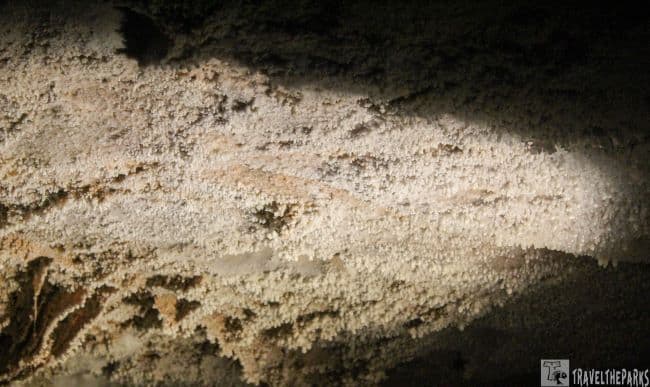
PRO Tip: A limited number of tickets will be available for purchase in person at the visitor center on a first-come, first-served basis each day.
Pick the Perfect Tour: Wind Cave Day Trip Guide for First-Time Visitors
They offered three different tours during the summer. For specific information, refer to the parks website.
- Garden of Eden Tour: The easiest starts and ends at the elevator. An hour it comprises 150 stairs over 1.3-miles. Entrance and exit to the cave system is by elevator for this tour. It is suitable for elders and children of all ages.
- The Natural Entrance Cave Tour: This is the most popular tour. A moderate walk it takes 90-minutes to trek 0.6 miles, includes 300 stairs. No Elevator down, ride up at the end.
- Fairgrounds Tour: The most strenuous trek at 75-minutes covering 0.6 miles with 450 stairs.

Feeling more adventurous? They offer two additional special tours during the summer:
- Wild Cave Tour: This is a 4-hour small group. Requires rigorous crawling required in tiny spaces, must be 16 years or older. For those that want to experience natural caving.
- Candlelight Tour: Follow the path of the earliest explorers by candlelight. Noted as strenuous as it takes 2-hours. Children must be 8 years old. Requires some stooping & squeezing through tight spaces (gloves provided). Limited to 10 people.

Why We Chose the Garden of Eden Tour
Since we only had a limited time at the park on our itinerary for our day visit, we selected the Garden of Eden Tour—a great introduction for first-time visitors. Following the instructions in our reservation confirmation, we arrived about 30 minutes early for our 9:40 AM tour to check in and receive our tickets.
Cristina, our park ranger and guide, led an engaging and informative tour. Before descending into the cave by elevator, she shared a brief history of Wind Cave. Legend has it that in 1881, brothers Jesse and Tom Bingham were out hunting when they heard a mysterious whistling sound. Investigating the noise, they discovered the natural entrance to the cave—a hole in the ground so powerful with wind it reportedly blew Jesse’s hat off.
As we explored the chambers, our guide continued the tale, highlighting the efforts of early explorer Alvin McDonald, who began mapping the complex labyrinth in the late 1800s. Thanks to more than a century of exploration, over 147 miles of passageways have now been documented—making Wind Cave one of the longest and most intricate caves in the world.


Inside Wind Cave: First Impressions of the Spectacular Boxwork Formations
PRO Tip: The ranger will ask for a volunteer to be the caboose. This allows you to take photographs with no people. We volunteered at both Wind & Jewel Cave.
The elevator quickly descends 500 feet below the surface. Exiting the elevator, the first expansive room we entered showed extensive boxwork formations. This cave system is most renown for the immense amount of boxwork formations. Approximately 95% of the world boxwork can be found here.
Although smaller in size to the immense Big Room at Carlsbad Caverns, the formations here are still very elaborate. The intricate boxwood formations here reminded me of a little post office box. The ranger explained the honeycomb-patterned boxwork is made of calcite blades protruding from cave walls and ceilings. Each fin intersects a neighbor’s at a different angle, thus forming a “box” on every cave wall.

Boxwork: An Unusual Cave Formation
Our ranger guide explained they consider this cave to be dry, so don’t expect to see stalagmites and stalactites. We learned a Speleothem, such as flowstone, cave popcorn and frostwork, are cave formations created by the deposition of sediments. While the opposite is Speleogens such as boxwork are created by the removal of bedrock.

Other rooms had mysterious geological formations, such as cave popcorn. The formation of popcorn nodules occurs in areas with a higher airflow, which leads to faster evaporation and the creation of popcorn-like nodules of calcite. Sometimes we find frostwork along with cave popcorn-like aragonite crystals that look like needles of frost.

Flowstone forms from calcite or other carbonate minerals. To us, it looks like a river. Smooth sheet-like deposits formed the appearance along the walls or floors of caves when water flows down them.
Near the end, the ranger-guide will turn off the lights. You get to experience the cave in total darkness. It was eerie not being able to see my hand in front of my face.

Wind Cave National Park Scenic Drive on Highway 87
The scenic Hwy 87 connects directly to Custer State Park-Wildlife Loop Road. Our second destination on today’s journey. There is so much more to see at the park than just the underground cave tours. Don’t miss out on the above ground mixed prairie as well. It was a totally unexpected surprise to see wildlife around every twist and turn of the road.

The first not to be missed viewpoint is the Beaver Creek bridge. Rising 115 feet above the canyon floor, they built the Beaver Creek bridge in 1929. Historically important, the iconic structure is on the National Register of Historic Places. The bridge builders wanted to give the impression that the concrete arches on opposite sides of the canyon rise naturally from the rock walls. Look for the pullout approximately 2-miles from the visitor center-we almost missed.
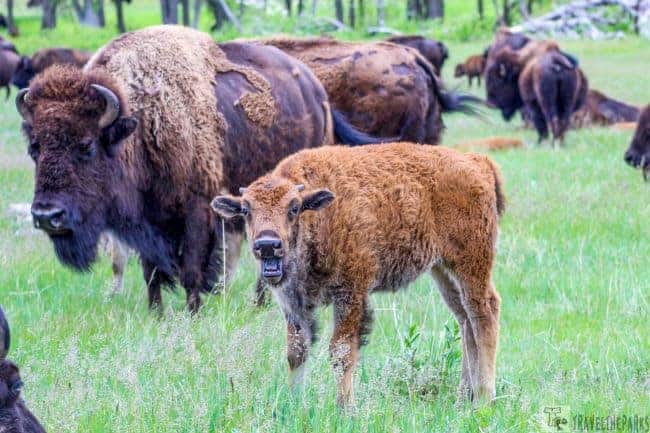
Unsurpassed Wildlife in Wind Cave National Park
The park has plenty of wildlife to see on the scenic roadway. Just remember to give them some space. Bison share the mixed-grass prairie and pine forest of Wind Cave National park with a variety of other wildlife. It is an interesting fact that this bison herd is one of only four free roaming in North America. This particular herd is genetically pure and unhybridized. Shortly after leaving the Beaver Creek area, we encountered a herd of bison, including a few “red dogs,” which were very cool. A reddish-brown coat gives the calves their name “Red dog.” Further along the road, we spotted a lone pronghorn feeding on meadow grasses.

We found prairie dog towns along different trails within the park. We could hear their yips and squeaks from a distance. They are extremely comical to watch, darting from burrow to burrow. Wish we had seen ferrets. In 1981, a small population of black-footed ferrets was discovered in Wyoming, which had been thought extinct. A small and stable population of the species has existed in Wind Cave since 2007 after reintroduction.
Tip: There are no is no food service in the park. Pack a picnic lunch to eat at a pullout or on the trail.

Hiking Trails in Wind Cave National Park
There are over 30 miles of trails in Wind Cave National Park, which are split between ponderosa pine and mixed-grass prairie. Watch for poison ivy, ticks and give wildlife a wide berth on trails. Bring plenty of water, snacks, binoculars, trekking poles, sunscreen, and a hat. A day pack is ideal. Bug spray for the summer months is recommended.

- Prairie Vista trail-Just outside the visitor center, this is an easy 1-mile hike passing the Natural entrance to wind cave.
- Rankin Ridge Trail-If you only have a limited time to explore, the Rankin Ridge trail is the best option for hiking. The old Fire Lookout Tower dominates the highest point in the park. On a clear day, you can see all the way to the Badlands National Park.
- Elk Mountain Interpretive trail is a 2.5 mile out & back hike. The interpretive part of the trail is a 1.2-mile loop that starts at the campground.
- Centennial Trail & Lookout Point Loop is a moderate 4.5-mile loop. The trail takes you through open prairie meadows, eventually descending to Beaver Creek. Look for bison, give them plenty of space.
- Cold Brook Canyon Trail-Moderate 2.8-mile trail descends to the canyon floor through open prairie and ponderosa forest. The prairie dog town is the highlight, they are just so cute!
- Centennial Trail-Those who have wanderlust may want to consider hiking the entire 111-mile trail. It runs through the varied terrain of the Black Hills from Wind Cave to Bear Butte State Park.
PRO Tip: Similar to Badlands National Park, Wind Cave has an open hike policy. Beware your step. Prairie rattlesnakes are found in the park.

Final Thoughts: Powerful, Unexpected Day in Wind Cave National Park
We had an incredible time at wind cave! Because of the Black Hills’ proximity, you can easily combine either Custer State Park or Jewel Cave National Monument with Mount Rushmore National Memorial. Despite Wind Cave’s size, the cave’s formations aren’t as spectacular as those of the aforementioned cave. I have to say we had a remarkable day at Wind Cave National Park. Wind Cave is an amazing and unique National Park that we both highly recommend visiting. ⠀
Have you visited Wind Cave? Have you caught a sunrise in Wind Cave? What’s your favorite memory of Wind Cave? Tell us your favorite spot in the comments below!

